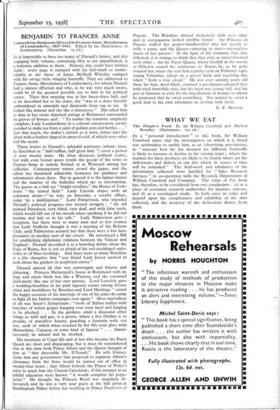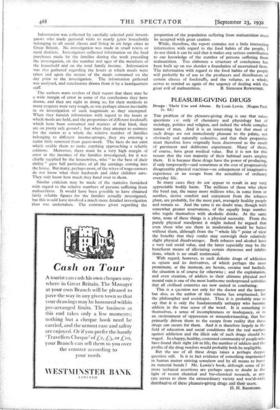WHAT WE EAT
The People's Food. By Sir William Crawford and Herbert Broadley. (Heinemann. 12s. 6d.)
IN a " personal introduction " to this book, Sir William Crawford states that the investigation on which it is based was undertaken to enable him, as an advertising practitioner, to " measure how far the demand for different foodstuffs is likely to increase or decline in the coming years ; where the markets for these products are likely to be found, where are the deficiencies and defects in our diet which in course of time will be remedied." The field-work and tabulation of the information collected were handled by " Sales Research Services " in co-operation with the Research Department of William Crawford and Company. The value of this book has, therefore, to be considered from two standpoints : (a) as a piece of consumer research undertaken for business reasons, and (b) as a sociological study. In both cases its value will depend upon the completeness and reliability of the data collected, and the accuracy of the deductions drawn from them.
Information was collected by carefully selected paid investi- gators who made personal visits to nearly 5,000 households belonging to all social classes and living in six large cities in Great Britain. No investigation was made in small towns or rural districts. Investigators collected information on the food purchases made by the families during the week preceding the investigation, on the number and ages of the members of the household and on the total family income. Information was also gathered regarding the hours at which meals were taken and upon the menus of the meals consumed on the day prior to the investigation. The information gathered was analysed, and conclusions drawn from it by a headquarters staff.
The authors warn readers of their report that there may be a wide margin of error in some of the conclusions they have drawn, and they are right in doing so, for their methods in many respects were very rough, as was perhaps almost inevitable in an investigation of such magnitude as they attempted. When they furnish information with regard to the hours at which meals are held, and the proportions of different foodstuffs which have been consumed and matters of that kind, they are on pretty safe ground ; but when they attempt to estimate for the nation as a whole the relative number of families belonging to different income-groups, they are entering a realm little removed from guess-work. The facts do not exist which enable them to make anything approaching a reliable estimate. Moreover, there must be a very high margin of error in the incomes of the families investigated, for it was chiefly supplied by the housewives, who " to the best of their ability " gave full particulars of all the earnings coming into the house. But many, perhaps most, of the wives of wage-earners do not know what their husbands and elder children earn. They only know how much they hand over to them.
Similar criticism may be made of the statistics furnished with regard to the relative numbers of persons suffering from malnutrition. It would have been possible to have obtained fairly reliable figures for the families actually investigated, but this would have involved a much more detailed investigation than was undertaken. The estimates given regarding the
proportion of the population suffering from malnutrition-must be accepted with great caution.
While, therefore, the report contains not a little interesting information with regard to the food habits of the people, I do not think it can be said that it makes any serious contribution to our knowledge of the number of persons suffering from malnutrition. Too elaborate a structure of conclusions has been built up on too slender a foundation of ascertained facts. The information with regard to the food habits of the people will probably be of use to the producers and distributors of certain classes of foodstuffs, and the volume, as a whole, serves to remind us again of the urgency of dealing with the







































 Previous page
Previous page